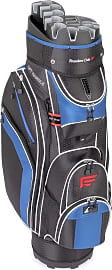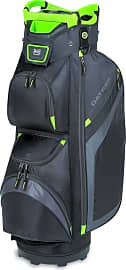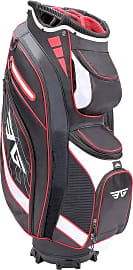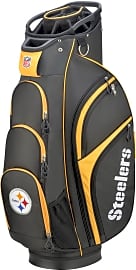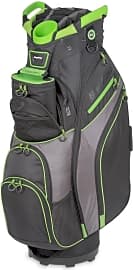The 10 Best Golf Cart Bags

This wiki has been updated 39 times since it was first published in June of 2016. For those who disagree with Mark Twain's rude assertion that "Golf is a good walk spoiled," you can thumb your nose at him by using one of these cart bags in your buggy. This way, you can conserve the energy you'd otherwise spend while trekking the course for those final holes. These come with an array of features and at prices to suit everyone from the occasional player to the professional. When users buy our independently chosen editorial selections, we may earn commissions to help fund the Wiki.
Editor's Notes
April 04, 2020:
The Callaway Golf Org 15, Ping Pioneer, and Tour Edge Hot Launch 2 were no longer available, so all three were removed. Upon review, we also rearranged a few of the existing items.
Despite the description of the Prosimmon Tour touting 14 dividers, only four of those are full length, which is one reason we downgraded its ranking. It’s lightweight and affordable, but it’s best suited for occasional players, since it will likely break down quickly if used weekly or daily. Conversely, we learned that the Datrek DG Lite II is an exceptional value for the range of features it provides: 14 full-length dividers, roomy apparel compartments that can easily house jackets, well-placed grab handles, a towel ring, and plenty more. We upgraded this bag.
Many options — including all three of our new additions — include an insulated cooler pocket for beverages. If you don’t find this feature important, you may want to consider a model without one, as this compartment can take up considerable space on some bags. The cooler area on the Sun Mountain C-130 is built with holes for ventilation and drainage, which is a nice touch.
Another key attribute to note when evaluating options: the dividers. Be sure to check whether they run the full length of the bag, because if they don’t, there’s a greater chance of clubs getting tangled. Some models have special external tubes for storing putters separately.
Special Honors
Vice Pride A sleek black accessory with neon lime green accents, the Pride bag will inject some flamboyance into a traditionally conservative sport. It’s compatible with both trolleys and driving carts, and with its padded shoulder strap, it’s easy to carry as well. It offers 15 individual storage compartments. vicegolf.com
Pete’s Golf Cart Bag Holder A cart bag isn’t much use if there’s nowhere on the vehicle to store it. This holder is a nice solution for such situations, as it can easily be mounted to the safety grab bar of a standard golf cart. Once set up, it accommodates two bags, and no additional hardware is required. petesgolfcarts.com
Morocco This stylish ladies’ bag features a detachable purse cover and rain hood for use when wet weather strikes. Its easy-access tee holders are a nice touch, and its pouch for valuables is lined with soft velvet. You also have the option to place a customized monogram on the front or side pocket. sassycaddy.com
Choosing A Golf Bag That Will Last
Depending on your style, a few of these features might come in handy, although they could also deprive you of some space.
The first priority whenever choosing a golf bag should be ease of transport. A decent bag can weigh anywhere between 3-13 lbs, with lighter bags built sleek, and heavier bags built deep with added compartments and more durable material. It's important to keep in mind that the heavier a bag, the greater the need for wheels and a handle, if not a looping strap for securing that bag onto a cart. If you golf without a caddie, you may also want a bag to come with a flip stand or a molded base, either of which can enable a bag to stand upright, thereby preventing the bag's exterior from getting damp or accumulating a green film along its sides.
Precautions notwithstanding, it's safe to assume that sooner or later a golf bag is going to get wet. With that in mind, you'll want to confirm that any bag's material is either waterproof or water-resistant, and that the bag has been designed with some type of mechanism - whether it be a rain hood, a top cover, or an umbrella holder - to keep rain from building up. Along those lines, you'll want to ensure that almost all of a bag's pockets can be secured, or zipped shut. One exception might be a mesh pocket, as the elastic band on a mesh pocket can be used to air out damp items.
Certain bags are designed with gimmicky features like a built-in radio or a cooler (for refrigerating beverages). Depending on your style, a few of these features might come in handy, although they could also deprive you of some space. The best way to account for this is by making a list of all the ancillary items that you'll need a bag to carry. Doing so will help you to determine whether a specific model can accommodate your needs.
Important Tips For Keeping Your Golf Bag Organized
When arranging a golf bag, most experts recommend that you start by placing the smallest clubs in first. These clubs should be stored inside the bag's rear compartment (i.e., the compartment that sits furthest from your body whenever the bag is strapped to your shoulder). The reason being that whenever a bag is tilted, the smallest clubs are always the least likely to teeter out, or angle forth.
The reason being that whenever a bag is tilted, the smallest clubs are always the least likely to teeter out, or angle forth.
Assuming your bag has four central compartments, you'll want to divide your irons chronologically throughout the three bottom-most compartments, while placing your woods, your wedge, and your putter in the compartment nearest the strap. Distributing the weight equally in this manner will keep your bag from getting front-heavy, and it will also make it easier to locate a specific club whenever you're trying to make a shot.
If you're constantly switching the set of clubs that you play with, it might be worth taping a list of which clubs belong in each compartment along the lip of your bag. Either that or use your cellphone to take an overhead photo of your bag with all of the clubs positioned in their proper spots.
Regarding the bag's outside pockets, the common-sense rule is that drinks and snacks should be placed in a separate pocket from towels and gloves. Towels and gloves may be sweaty, or plagued with odor-causing bacteria. Balls and tees should be afforded their own pockets, and - given these items are used so often - those pockets should be located near the bag's top. Tees, in particular, need to be separated from other items to avoid anything valuable getting punctured or damaged by a tee's point.
A Brief History of Golf's Most Time-Honored Course
The early days of Scottish golf were mired in controversy, much of it a result of the pastime being banned in 1457 by James II, who viewed golf as a distraction from utilitarian sports like fencing and archery. Ironically, one of golf's most common settings during this era became a sprawling green along the Scottish east coast. This green was known as St. Andrews, and - up until the royal ban was lifted in 1502 - the players at St. Andrews were defying Scottish law in open sight.
The cost of maintaining the greens became so overwhelming that, for a time, a portion of the property needed to be reallocated toward selling rabbits.
In 1552, Archbishop John Hamilton declared the links at St. Andrews officially open to the public. More than anything else, this meant mainstream acceptance for golf, wholly endorsed by the vicars of the Church, no less. Throughout the 1600s, St. Andrews proved to be a popular - if not wholly profitable - destination. The cost of maintaining the greens became so overwhelming that, for a time, a portion of the property needed to be reallocated toward selling rabbits.
The issue was that golf was largely viewed as a commoner's sport, and, as such, it failed to attract the type of audience that could afford to sustain its lavish greens. This eventually led to a lot of golf courses (including St. Andrews) being reconstituted as exclusive "clubs" for society's elite. Admission fees became memberships; donations became endowments. Every course was rebuilt around a central meeting hall, with St. Andrews becoming one of the first major clubs to downsize its course from 22 holes to 18.
Today, golf's oldest major tournament, the Open Championship, continues to be played at St. Andrews once every five years. What's more, well over 20,000 people make an annual pilgrimage to St. Andrews, where the bedrock attraction has long been a tour of the original course, a course that was unofficially conceived well over 500 years ago.



